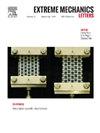Magnetic field induced toughening mechanisms in isotropic and anisotropic soft magnetoactive elastomers
IF 4.5
3区 工程技术
Q2 MATERIALS SCIENCE, MULTIDISCIPLINARY
引用次数: 0
Abstract
Soft magnetoactive elastomers (sMAEs) are promising multifunctional composites obtained by embedding soft-magnetic particles into an elastomer matrix. Under external magnetic fields, these composites exhibit tunability in mechanical and rheological properties, including stiffness modulation and controllable deformation. Despite growing interest in their magneto-mechanical capabilities, the fracture behavior of sMAEs under magnetic fields remains entirely unexplored. Here, we present the first comprehensive experimental characterization of the fracture toughness and underlying fracture mechanisms in sMAEs subjected to magnetic fields. The study includes different volume fractions of particles, with particles arranged both randomly and aligned, parallel and perpendicular to the loading direction. Experimental results show that in the presence of a magnetic field, fracture toughness increases by 42% for anisotropic sMAEs and 23% for isotropic sMAEs, compared to their unmagnetized states. With the aid of the load-stretch curves, spatial distribution of strain from Digital Image Correlation (DIC), and optical microscopy images of the test specimens, we identify two key mechanisms driving the observed toughening: bulk magneto-mechanical induced stiffening and/or local magneto-mechanical coupling near the crack tip that delays catastrophic failure. This work bridges a critical knowledge gap and expands the design space for durable and adaptive multifunctional magneto-responsive composites.
各向同性和各向异性软磁活性弹性体的磁场诱导增韧机制
软磁活性弹性体(sMAEs)是一种很有前途的多功能复合材料,它将软磁颗粒嵌入弹性体基体中。在外加磁场作用下,复合材料表现出力学和流变性能的可调性,包括刚度调制和变形可控。尽管人们对它们的磁机械性能越来越感兴趣,但它们在磁场下的断裂行为仍然完全未被探索。在这里,我们提出了第一个综合的实验表征的断裂韧性和潜在的断裂机制,在磁场作用下的中小微材料。研究中包含了不同体积分数的颗粒,颗粒的排列有随机的也有排列的,平行于加载方向的也有垂直于加载方向的。实验结果表明,在磁场作用下,各向异性微晶合金的断裂韧性比未磁化状态分别提高了42%和23%。借助载荷-拉伸曲线、数字图像相关(DIC)应变的空间分布以及试样的光学显微镜图像,我们确定了驱动所观察到的增韧的两个关键机制:体磁力诱导的增韧和/或裂纹尖端附近的局部磁力耦合,延迟了灾难性破坏。这项工作弥补了关键的知识差距,扩大了耐用和自适应多功能磁响应复合材料的设计空间。
本文章由计算机程序翻译,如有差异,请以英文原文为准。
求助全文
约1分钟内获得全文
求助全文
来源期刊

Extreme Mechanics Letters
Engineering-Mechanics of Materials
CiteScore
9.20
自引率
4.30%
发文量
179
审稿时长
45 days
期刊介绍:
Extreme Mechanics Letters (EML) enables rapid communication of research that highlights the role of mechanics in multi-disciplinary areas across materials science, physics, chemistry, biology, medicine and engineering. Emphasis is on the impact, depth and originality of new concepts, methods and observations at the forefront of applied sciences.
 求助内容:
求助内容: 应助结果提醒方式:
应助结果提醒方式:


